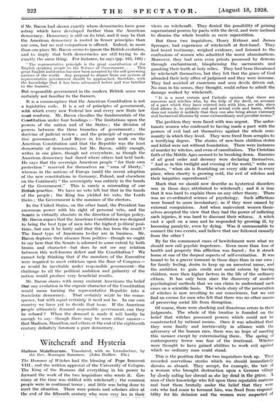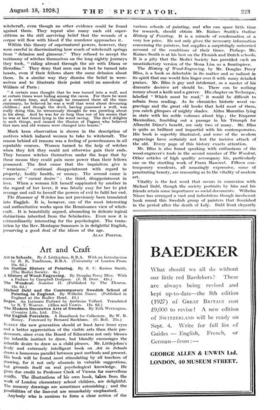Witchcraft and Hysteria
Malleus Maleficarum. Translated, with an Introduction, b3i the Rev. Montague Summers: (John- Rodker. 35s.)
The Hammer of Witches had the blessing of Pope Innocent VIII., and the written approval of the University of Cologne.
The King of the Romans did everything in his power t6
forward the work of the two inquisitors who wrote it. Ger. -
many at the time was riddled with witchcraft.; the common
people were in continual terror ; and little was being done to meet the situation. There were priests and scholars alive at the end of the fifteenth century who, were very lax in theii views on witchcraft. They denied the possibility of gaining supernatural powers by pacts with the devil, and were inclined to dismiss the whole trouble as mere superstition.
But these two inquisitors, Henry Kramer and James Sprenger, had experience of witchcraft at first-hand. They had heard testimony, weighed evidence, and listened to the confessions of women who admitted the worst abominations.
Moreover, they had seen even priests possessed by demons through enchantment, blaspheming the sacraments and gnashing their teeth at holy relics. They had been threatened by witchcraft themselves, but they felt that the grace of God attended their holy office of judgment and they were immune. They had assisted at exorcisms and seen devils driven out. No man in his senses, they thought, could refuse to admit the damage worked by witchcraft.
"It is a most certain and Catholic opinion that there are sorcerers and witches who, by the help of the devil, on account of a pact which they have entered into with him, are able, since God allows it, to produce real and actual evils and harm, which does not render it unlikely that they can also bring about visionary and fantastical illusions by some extraordinary and peculiar means.'
The problem they were faced with was urgent. The unfor- tunate women who confessed to having made a pact with the powers of evil had set themselves against the whole com- munity in which they lived. They were freed from scruples to a terrifying degree. The stories of new-born children stolen and killed were not without foundation. There were instances of murder by witches, and even of cannibalism. The Christian faith of the Middle Ages seemed to be breaking down. Enemies of all good order and decency were declaring themselves. "And so in this twilight and evening of the world," write our authors, "when sin is flourishing on every side and in every place, when charity is growing cold, the evil of witches and their iniquities superabound."
Much that we should now describe as hysterical disorders was in those days attributed to witchcraft ; and it is true that it was hard to explain them on any other theory. There was no co-ordinated science of psychology. Such afflictions were bound to seem involuntary, as if they were caused by external compulsions. And when malevolent women 'them.; selves accepted the view that they had the power of inflicting such injuries, it was hard to discount their witness. A witch cast a spell on a man and he responded by growing ill, by becoming paralytic, even by dying. Was it unreasonable to connect the two events, and believe that one followed causally from the other ?
By far the commonest cases of bewitchment were what we should now call psychic impotence. Even more than loss of health and property this affliction was feared ; for it struck home at one of the deepest aspects of self-evaluation. It was bound to be a graver torment in those days than in our own ; for family feeling, desire to keep up an ancestral name, and the ambition to gain credit and social esteem by having children, were then higher factors in the life of the ordinary citizen. It has only been since the discovery of modem psychological methods that we can claim to understand such cases on a scientific basis. The whole story of the persecution of witches is now revolting to our consciences, but we can find an excuse for men who felt that there was no other means of preserving social life from disruption.
Of course, there were shocking and disastrous errors in their judgments. The whole of this treatise is founded on the belief that witches possessed powers which could not be counteracted by rational means. Once it was admitted that
they were finally and irretrievably in alliance with the adversary of the human race, there was no hope of meeting this menace except by exterminating them. The spring of contemporary terror was fear of the irrational. Witches were thought to have gained abilities to work evil against which no ordinary man could stand.
This is the position that the two inquisitors took up. They recorded marvellous stories which we should immediately dismiss as absurd. They accept, for example, the tale of a woman who brought destruction upon a German village
by slowly eating her shroud as she lay dead in the grave. A man of their knowledge who fell upon three reputable matrons and beat them , brutally under the belief that they were cats who had, come to torment him, was freed from responsi- bility for his delusion and the women were suspected of
witchcraft, even though no other evidence could be found against them. They repeat also many such old super- stitions as the still surviving belief that the wounds of a corpse will flow with blood if the murderer approaches it.
Within this theory of supernatural powers, however, they were careful in discriminating how much of witchcraft springs from "delusion and glamour." They refused to accept the testimony of witches themselves on the long nightly journeys they took, "riding abroad through the air with Diana or Herodias." They deny that men can in fact be turned into beasts, even if their fellows share the same delusion about them. In a similar way they dismiss the belief in were- wolves and to illustrate their point retell an anecdote of William of Paris :
"A certain man thought that he was turned into a wolf, and at certain times went hiding among the caves. For there he went at a certain time, and though he remained there all the time stationary, he believed he was a wolf that went about devouring children ; and though the devil, having possessed a wolf, was really doing this, he erroneously thought he was prowling about in his sleep. And he was for so long thus out of his senses that he was at last found lying in the wood raving. The devil delights in such things, and caused the illusion of Pagans who believed that men and old women were changed into beasts."
Much keen observation is shown in the description of motives which induced women to take to witchcraft. The reason behind all reasons was a feeling of powerlessness in all reputable courses. Women turned to the help of witches when they felt they could not otherwise gain their ends. They became witches themselves under the hope that by these means they could gain more power than their fellows possessed. The first cause that the inquisitors give is "weariness," continual disappointment with regard to property, bodily health, or money. The second cause is excess of "carnal desire" ; the third, disappointment in
love. When a woman felt herself supplanted by another in the regard of her lover, it was fatally easy for her to plot revenge and call to.herself the powers of evil to fulfil her end.
The Hamner of Witches has not previously been translated into English. It is, how*Ver, one of the most interesting and authoritative works upon the Renaissance view of witch- craft., It is beautifully argued, abounding in delicate logical distinctions inherited from the Scholastics. Even now it is extraordinarily interesting for the psychologist. The trans- lation by the Rev. Montague Summers is in delightful English, preserving a good deal of the idiom of the age.
ALAN PORTER.

































 Previous page
Previous page